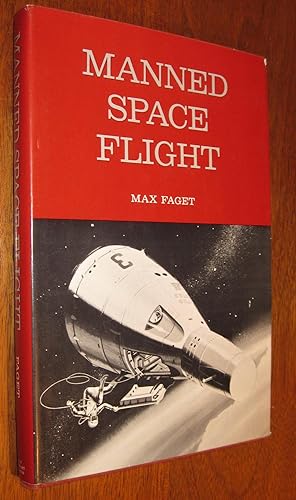Faget Max (6 results)
Product Type
- All Product Types
- Books (6)
- Magazines & Periodicals
- Comics
- Sheet Music
- Art, Prints & Posters
- Photographs
- Maps
-
Manuscripts &
Paper Collectibles
Condition
- All Conditions
- New
- Used
Binding
Collectible Attributes
- First Edition (2)
- Signed
- Dust Jacket (1)
- Seller-Supplied Images (1)
- Not Printed On Demand
Seller Location
Seller Rating
-
LOS VUELOS ESPACIALES TRIPULADOS
Published by POMAIRE, 1968
ISBN 10: 0000000345ISBN 13: 9780000000347
Seller: Librería Rola Libros, SEVILLA, Spain
Book
TAPA BLANDA. Condition: Regular. Ciencias naturales-exactas CONSULTE NUESTRAS CONDICIONES Y GASTOS DE ENVÍO.
-
Manned Space Flight (Holt library of Science)
Published by Holt, Rinehart and Winston January 1965, 1965
Seller: Dunaway Books, St. Louis, MO, U.S.A.
Hardcover. Condition: Good. Covers are lightly damaged from removed library label, and some dents. corners are bumped and rubbed.
-
Manned Space Flight
Published by Holt, Rinehart and Winston, Inc, New York, 1965
Seller: Ground Zero Books, Ltd., Silver Spring, MD, U.S.A.
First Edition
Trade paperback. Condition: Good. Versatron Corporation (Original drawings) (illustrator). Presumed First Edition, First printing. 176 pages. Illustrations. Bibliography. Index. Cover has some wear and soiling. Maxime Allen "Max" Faget (August 26, 1921 - October 9, 2004) was a Belizean-born American mechanical engineer. Faget was the designer of the Mercury spacecraft, and contributed to the later Gemini and Apollo spacecraft as well as the Space Shuttle. In 1958, Faget became one of the 35 engineers who formed the Space Task Group, creating the Mercury spacecraft. He based his designs on the aerodynamic work of Harvey Allen from the mid-1950s, and was instrumental in selecting the blunt-body shape that won the Mercury competition over numerous contenders. He led the development of the escape tower system used on Mercury, which was used in various forms on almost all following crewed spacecraft. He also worked on the Gemini and Apollo vehicles, which shared many design points with the Mercury. In 1962 Faget became the Director of Engineering and Development at the Manned Spacecraft Center and continued to work for NASA until his retirement in 1981, shortly after the second Space Shuttle flight (STS-2). Faget was inducted into the 1969 National Inventors Hall of Fame, and received the NASA Outstanding Leadership Medal and John J. Montgomery Award. He was inducted into the Houston National Space Hall of Fame in 1969. He was inducted into the International Space Hall of Fame in 1990. Faget was inducted into the National Aviation Hall of Fame in 2020. The design, construction and successful operation of manned spacecraft represent one of the great engineering accomplishments of recent years. The natural difficulties that must be overcome in making space flight safe and reliable are so great that every possible advantage must be taken of modern science and technology. It is the purpose of this book to discuss some of the technical problems facing the builders of manned spacecraft, and to explain the various facets of science which came into play in the engineering solutions of these problems. The general intention is to emphasize fundamental concepts, It is hoped that the reader's interest will be excited to the extent that he or she will delve further into the adventures of the world of space technology. Human spaceflight (also referred to as manned spaceflight or crewed spaceflight) is spaceflight with a crew or passengers aboard a spacecraft, often with the spacecraft being operated directly by the onboard human crew. Spacecraft can also be remotely operated from ground stations on Earth, or autonomously, without any direct human involvement. The first human in space was Soviet cosmonaut Yuri Gagarin, who launched as part of the Soviet Union's Vostok program on 12 April 1961 at the beginning of the Space Race. On 5 May 1961, Alan Shepard became the first American in space, as part of Project Mercury. Humans traveled to the Moon nine times between 1968 and 1972 as part of the United States' Apollo program, and have had a continuous presence in space for 22 years and 179 days on the International Space Station (ISS).
-
MANNED SPACE FLIGHT
Published by HOLT RINEHART AND WINSTON, USA, 1965
Seller: HISTOLIB - SPACETATI, AIX-VILLEMAUR-PALIS, France
Book
Couverture souple. Condition: Satisfaisant. Format:13,5/20 EX LIBRIS HOLT LIBRARY OF SCIENCE SERIES III SPACEFLIGHT MISSIONS AND ENVIRINMENT.SPACECRAFT AND CREW. NAVIGATION GUIDANCE CONTROL . LAUNCHING .PROVIING FOR THE CREW .TRACKING .
-
Tapa Blanda. Condition: Bien. FOTOS: No dude en pedir mas imagenes. Es de segunda mano, como se ve en la foto, puede preguntar mas detalle del ejemplar.
-
Manned Space Flight
Published by Holt Rinehart Winston, 1965
Seller: Rare Reads, Athens, GA, U.S.A.
First Edition
Hardcover. Condition: Fine. Dust Jacket Condition: Fine. 1st Edition. top right corner of jacket has very minute chip that is barely noticeable otherwise fine condition book and jacket; borders on "A New" condition. You will not be disappointed in the quality and condition of this rare book.




